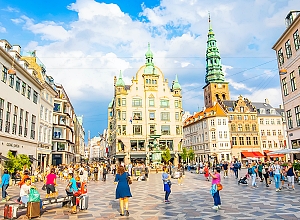For Danes, COVID-19 is officially over. Last Friday (10 September), the country lifted all of its last pandemic restrictions, with the government having declared the virus “no longer a critical threat to society”, thanks to having vaccinated 72% of the population.
Prime Minister Mette Frederiksen declared the vaccine “the super-weapon to beat them all”. “Everyday life is fortunately back in most places,” said Frederiksen, “and we have the clear expectation that we can avoid major lockdowns in the future.”
“The epidemic is under control,” Health Minister, Magnus Heunicke, announced last week, acknowledging that the governmentʼs right to impose special COVID-related powers was coming to an end, reports The Telegraph.
Denmark, which on 11 March 2020 was the first country in northern Europe to bring in lockdown restrictions, is now becoming the trailblazer in removing them. And in doing so, it could be teaching the rest of the world how to rebuild normality – even though the Danes are not claiming to have vanquished the disease, just to having found a way to live with it.
Their shift back to pre-pandemic life has been in the works for some months, with Denmarkʼs government arguing that with about 95% of vulnerable people, care home residents, and citizens over 60 fully vaccinated, the country could tolerate higher infection rates.
At the end of last month, the government announced plans to scale back its impressive testing infrastructure, with all rapid test sites to close by the end of September. It recently scrapped its one-metre rule, meaning there is no longer a need to keep seats empty in churches and cinemas.
From this week, school and daycare children will no longer be automatically sent home if a classmate or teacher gets COVID. And as of this month, people sitting in bars and restaurants no longer need to show a valid COVID pass (called a coronapas); 2 a.m. closing times have been lifted, and full-scale music festivals are allowed. Even nightclubs, after being closed for 18 months, have reopened.
All of this, despite the weekly number of people testing positive rising fivefold on lows seen at the end of June.
“We are seeing little serious disease in Denmark,” explains Viggo Andreasen, associate professor at Roskilde Universityʼs PandemiX Center. “So thereʼs definitely an understanding among politicians and the public that this is not a threat to society.”
Despite the case rates, Denmark is registering only a little more than 10 COVID deaths a week, down from the more than 200 it suffered during the worst weeks of the pandemic this January. The number of people being treated in hospital for COVID has doubled since the start of last month, with 123 patients on Tuesday 7 September.
Not that there is complacency in Copenhagen. Heunicke is warning that there is a risk of “an epidemic of the non-vaccinated”.
Among 15 to 18-year-olds, just 43.5% are fully jabbed; those in their 20s are also lagging behind. “In the winter, weʼre going to have a major epidemic in schools,” says Andreasen. “Thatʼs not generally accepted, but the evidence is pretty clear, particularly within primary schools.”
He estimates now restrictions are being lifted, about half of those who have yet to be vaccinated – either because they refuse the vaccine, havenʼt got around to getting it, or because they are under 12 – will be immune through infection within six months.
But while in the UK, the return to school has been filled with anxious calls for more masks, ventilation, testing and isolation, in Denmark the pressure on the government is in the other direction. The centre-Right Moderate party opposition, and two other smaller parties, last week called for children who have come into close contact with a person confirmed to be infected with COVID to no longer have to self-isolate at home.
Currently, teachers and pupils aged between 12 and 16 are encouraged but not required to get tested every 72 hours by rapid test or every 96 hours by PCR, while there is no advice for upper secondary students to get tested. The encouragement for pupils to get tested is due to finish by the end of this month, however, and might now be removed even earlier.
Not everyone is happy with the change in attitude and approach. Danes have a high level of trust in national experts, but for many foreigners living in the country, the switch from a timely and precautionary response in the first and second wave to a more gung-ho strategy post-vaccination is alarming.
“Looking at hospitalisations and kids in hospitals internationally, itʼs worrisome to me,” says Jonathan Bauer, an American who teaches English and art at a secondary school in Jutland, and whose wife is in a vulnerable group. “The pandemic is not over and I was on the train this morning and it was packed. It just makes me very uncomfortable.”
Bauer keeps the door open in the two lessons a week when he teaches unvaccinated under-12s.
Andreasen says that letting the virus run free in schools could bring unexpected dangers. He believes pupils who are close contacts of infected people should continue to be isolated and tested.
The Telegraph article – Welcome to Denmark, where COVID is over
See more from MedicalBrief archives:
Danish Mask Study: Why both proponents and opponents of masking hate it
Sweden's COVID-19 experiment has divided the world
Irish and Danish studies: 'Natural experiment' of lockdown sees fall in rate of premature birth

